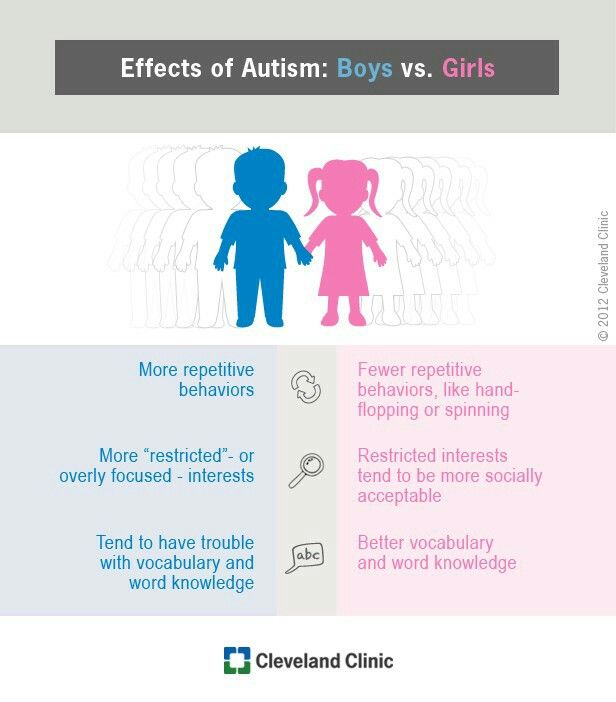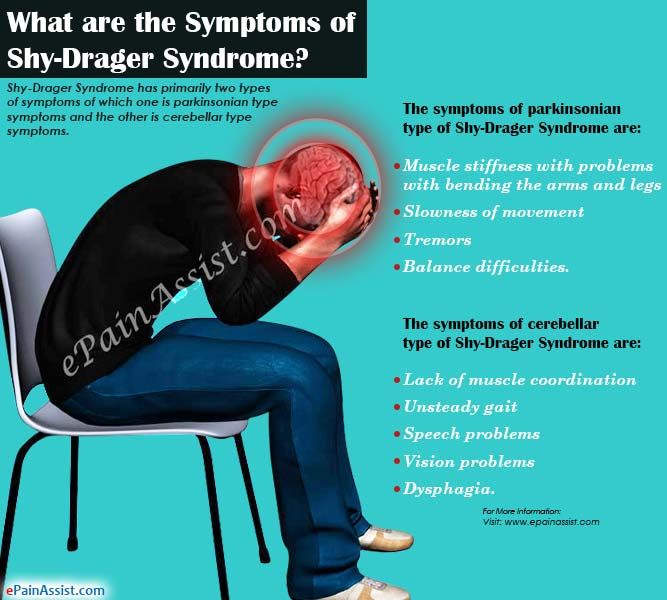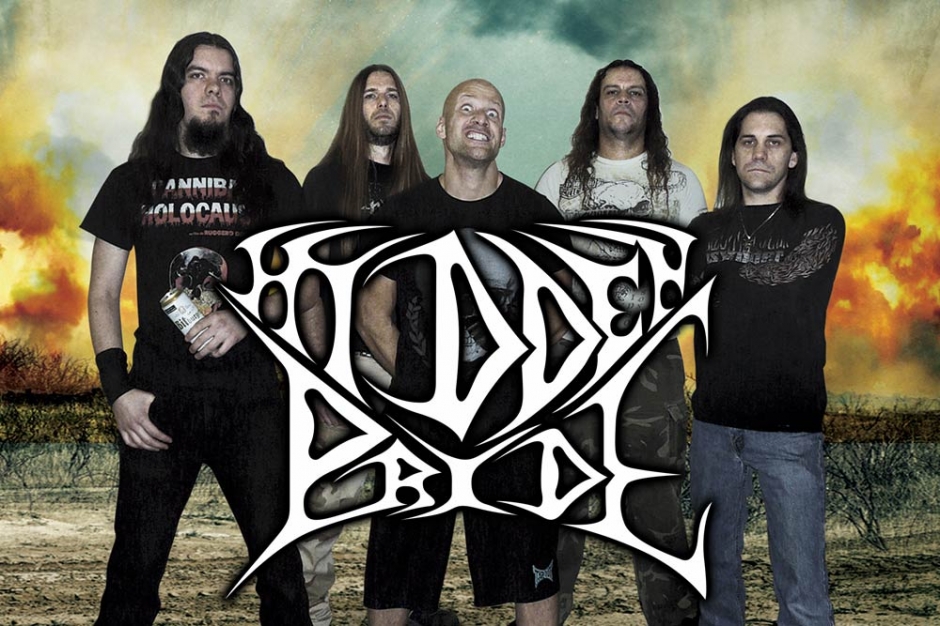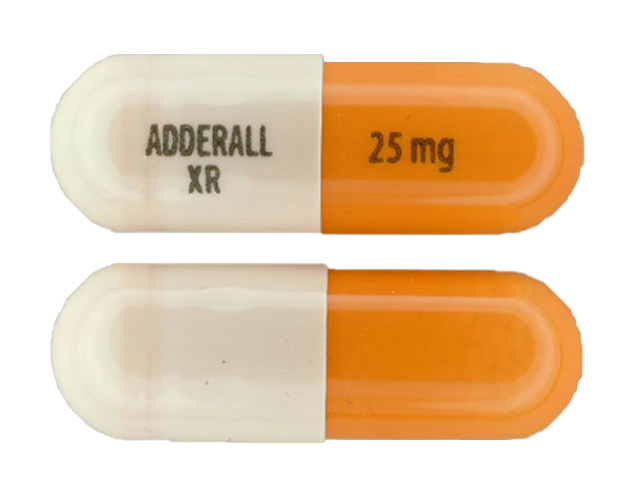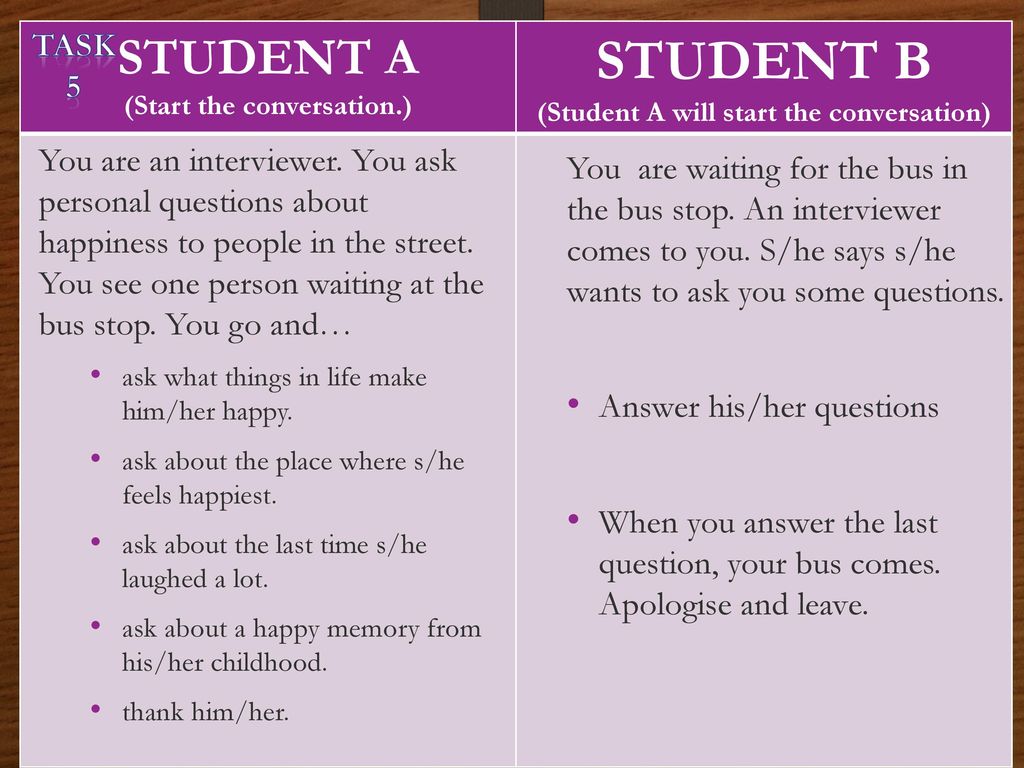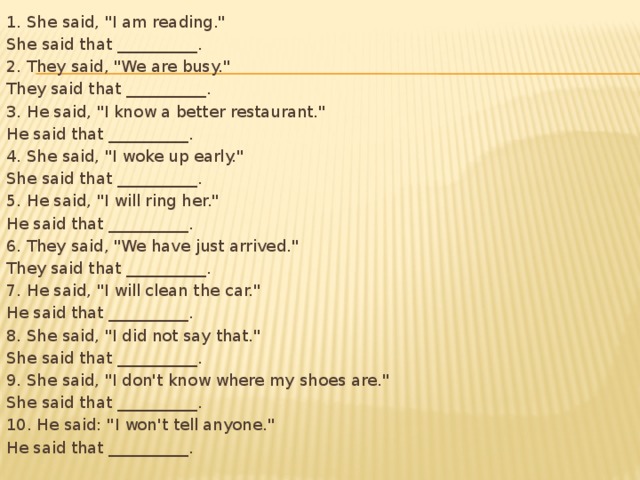Conditions of autism
Signs and Symptoms of Autism Spectrum Disorders
Autism spectrum disorder (ASD) is a developmental disability caused by differences in the brain. People with ASD often have problems with social communication and interaction, and restricted or repetitive behaviors or interests. People with ASD may also have different ways of learning, moving, or paying attention. It is important to note that some people without ASD might also have some of these symptoms. But for people with ASD, these characteristics can make life very challenging.
Learn more about ASD
Social communication and interaction skills can be challenging for people with ASD.
Examples of social communication and social interaction characteristics related to ASD can include
- Avoids or does not keep eye contact
- Does not respond to name by 9 months of age
- Does not show facial expressions like happy, sad, angry, and surprised by 9 months of age
- Does not play simple interactive games like pat-a-cake by 12 months of age
- Uses few or no gestures by 12 months of age (for example, does not wave goodbye)
- Does not share interests with others by 15 months of age (for example, shows you an object that they like)
- Does not point to show you something interesting by 18 months of age
- Does not notice when others are hurt or upset by 24 months of age
- Does not notice other children and join them in play by 36 months of age
- Does not pretend to be something else, like a teacher or superhero, during play by 48 months of age
- Does not sing, dance, or act for you by 60 months of age
Restricted or Repetitive Behaviors or Interests
People with ASD have behaviors or interests that can seem unusual. These behaviors or interests set ASD apart from conditions defined by problems with social communication and interaction only.
Examples of restricted or repetitive behaviors and interests related to ASD can include
- Lines up toys or other objects and gets upset when order is changed
- Repeats words or phrases over and over (called echolalia)
- Plays with toys the same way every time
- Is focused on parts of objects (for example, wheels)
- Gets upset by minor changes
- Has obsessive interests
- Must follow certain routines
- Flaps hands, rocks body, or spins self in circles
- Has unusual reactions to the way things sound, smell, taste, look, or feel
Other Characteristics
Most people with ASD have other related characteristics. These might include
- Delayed language skills
- Delayed movement skills
- Delayed cognitive or learning skills
- Hyperactive, impulsive, and/or inattentive behavior
- Epilepsy or seizure disorder
- Unusual eating and sleeping habits
- Gastrointestinal issues (for example, constipation)
- Unusual mood or emotional reactions
- Anxiety, stress, or excessive worry
- Lack of fear or more fear than expected
It is important to note that children with ASD may not have all or any of the behaviors listed as examples here.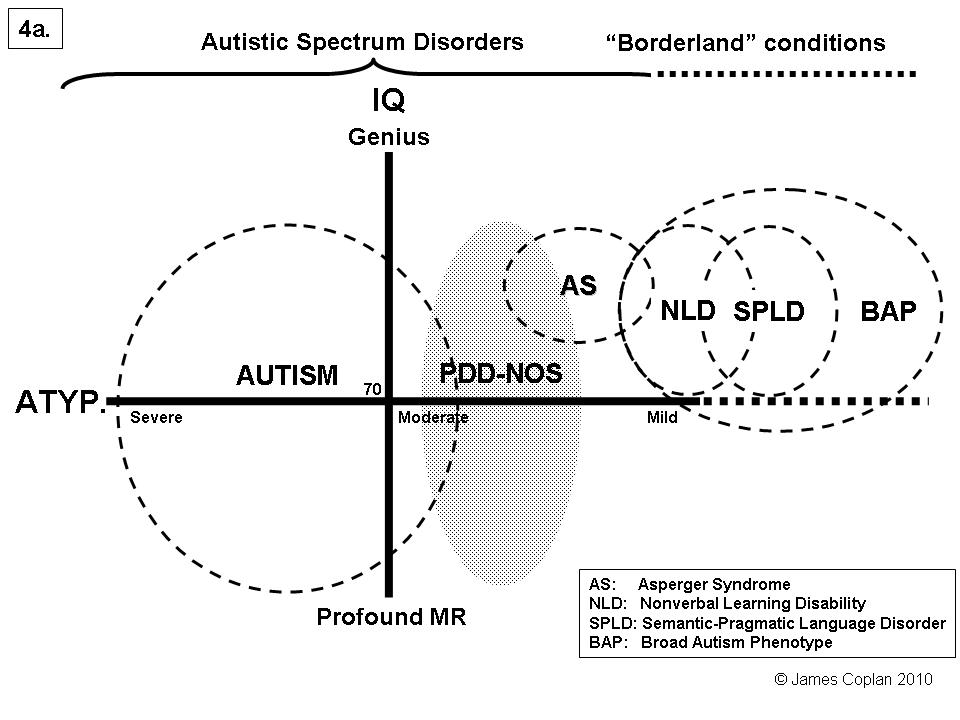
Learn more about screening and diagnosis of ASD
Learn more about treating the symptoms of ASD
Medical Conditions Associated with Autism
A range of physical and mental-health conditions frequently accompany autism. They include, but are not limited to, the following:
- Gastrointestinal (GI) problems
- Epilepsy
- Feeding issues
- Disrupted sleep
- Attention-deficit/hyperactivity disorder (ADHD)
- Anxiety
- Depression
- Obsessive compulsive disorder (OCD)
- Schizophrenia
- Bipolar Disorder
- Down syndrome (DS)
Autism and gastrointestinal (GI) disorders
GI disorders are nearly eight times more common among children with autism than other children.
They commonly include:
- Chronic constipation
- Abdominal pain
- Gastroesophageal reflux
- Bowel inflammation
The Autism Speaks Autism Care Network (ACN) has developed medical guidelines to help doctors recognize and manage these issues.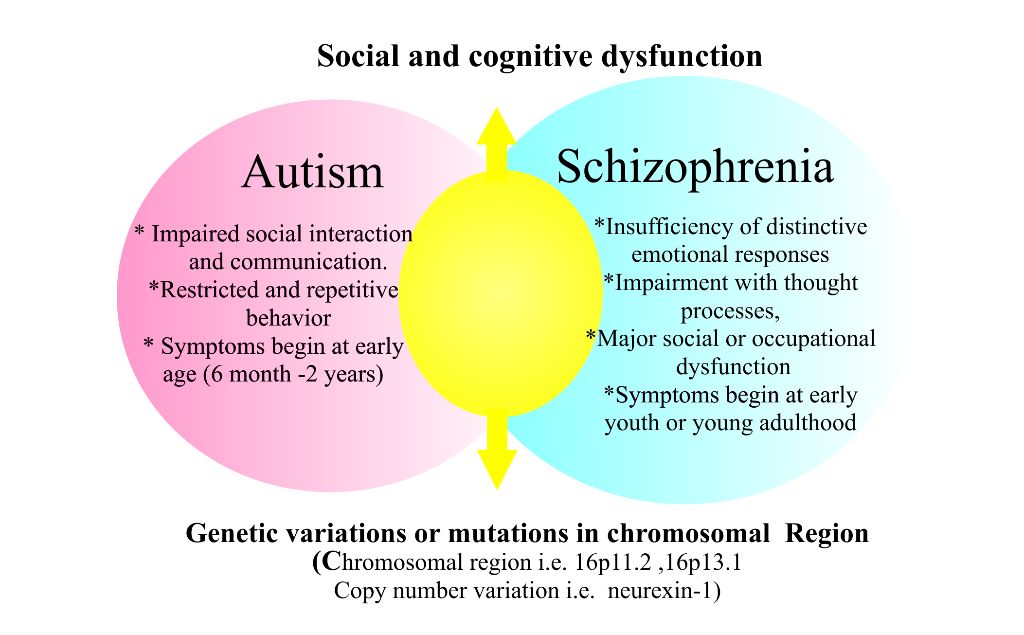
Also see: ATN/AIR-P Guide for Managing Constipation in Children
Autism and epilepsy
Epilepsy (seizure disorder) affects up to a third of people with autism. By contrast, it affects only 1 to 2 percent of the general population.Red flags include:
- Unexplained staring spells
- Involuntary movements
- Unexplained confusion
- Severe headaches
Less-specific signs can include:
- Sleepiness
- Disrupted sleep
- Unexplained changes in abilities or emotions
Treatment of epilepsy is crucial to prevent brain damage. If you suspect that you or your child may have epilepsy, seek evaluation from a neurologist. Evaluation typically involves an electroencephalogram (EEG) to check for seizure-related brain activity.
See these ATN/AIR-P Guidebooks:
- Having an Electroencephalogram (EEG): A Guide for Parents
- Having an Electroencephalogram (EEG): A Guide for Providers (caring for people with autism)
Explaining Seizures to Children with Epilepsy and Their Peers
Sometimes it can be difficult for children to understand what is happening when they are having a seizure.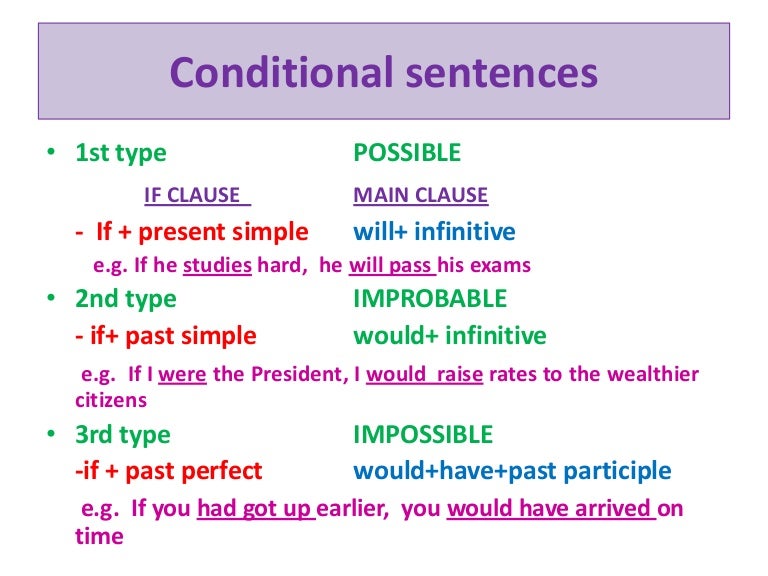 In addition, it can be very scary for their peers or friends who witness them. Autism Speaks has put together Visual Stories to explain to children how people with epilepsy are just like everyone else!
In addition, it can be very scary for their peers or friends who witness them. Autism Speaks has put together Visual Stories to explain to children how people with epilepsy are just like everyone else!
Visual Story for Children with Epilepsy
Visual Story for Peers of Children with Epilepsy
If a family member suffers from seizures, you may want to consider a medical alert bracelet that can inform first responders of the seizure disorder and any medications that the individual may take. There are a variety of options available on the internet.
Autism and feeding/eating issues
Feeding and eating problems affect around 7 out of 10 children with autism.
These issues can include extremely restricted food habits and aversions to certain tastes and textures. Many adults with autism likewise describe food aversions and restricted eating patterns.
These challenges often stem from autism-related hypersensitivities and/or a strong need for sameness.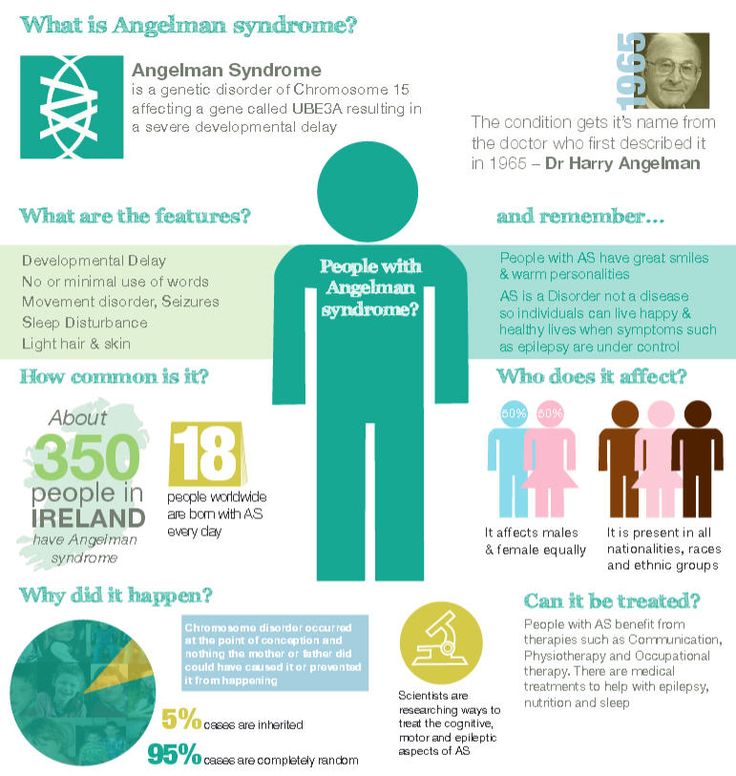
Chronic overeating leading to obesity is another challenge. It can stem from an inability to sense when “full” and/or eating as a soothing sensory behavior.
Pica – the eating of non-food items – is a particularly dangerous tendency often associated with autism. It appears to be most common among those severely affected by autism. See ATN/AIR-P’s Pica: A Guide for Parents.
Many autism clinics – such as those in the Autism Speaks ACN – have specialized feeding programs staffed by behavioral therapists and nutritionists. Outside such programs, some speech, behavioral and occupational therapists can help.
You can find helpful strategies in Exploring Feeding Behavior in Autism
Autism and disrupted sleep
Over half of children with autism – and possibly as many as four in five – have one or more chronic sleep problems.
Many adults on the spectrum likewise have difficulty falling asleep and staying asleep through the night.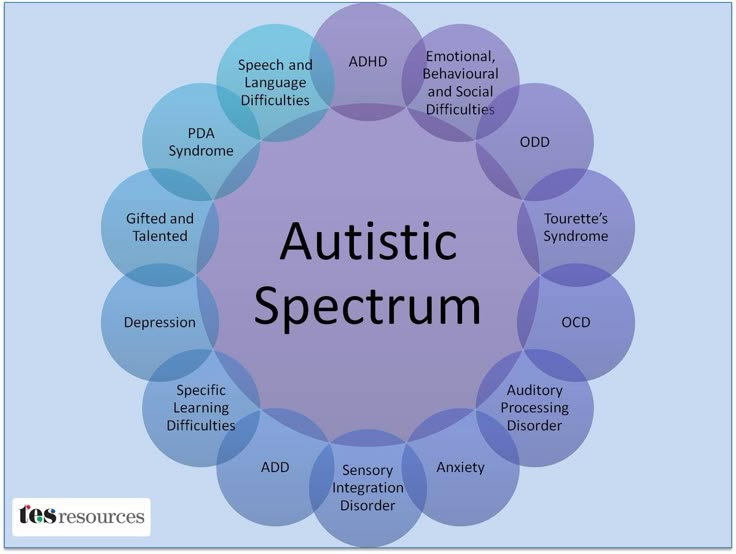 These sleep issues tend to worsen behavioral challenges, interfere with learning and decrease overall quality of life.
These sleep issues tend to worsen behavioral challenges, interfere with learning and decrease overall quality of life.
Researchers with the Autism Speaks ACN have developed and tested autism-specific strategies for improving sleep. These can be found in three ATN/AIR-P guidebooks:
- Strategies to Improve Sleep in Children with Autism Spectrum Disorder
- Sleep Strategies for Teens with Autism
- Melatonin and Sleep Problems in ASD: An ATN/AIR-P Guide for Parents
Autism and attention deficit and hyperactivity disorder (ADHD)
ADHD affects an estimated 30 to 60 percent of people with autism, versus 6 to 7 percent of the general population.
ADHD involves a persistent pattern of inattention, difficulty remembering things, trouble with managing time, organizational tasks, hyperactivity and/or impulsivity that interferes with learn and daily life.
Symptoms of ADHD can overlap with those of autism.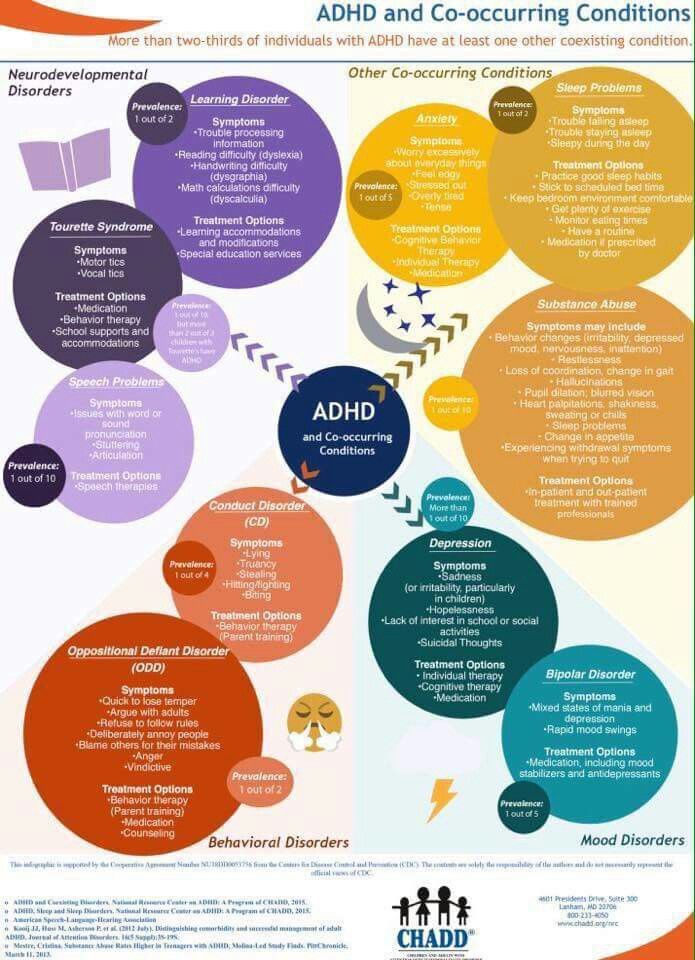 As a result, ADHD can be difficult to distinguish in someone on the spectrum.
As a result, ADHD can be difficult to distinguish in someone on the spectrum.
If you suspect that you or your child has autism and ADHD, we recommend evaluation by a specialist familiar with both conditions. If the evaluation confirms ADHD, ask your healthcare provider to help you tailor a treatment plan appropriate to you or your child’s needs.
Treatment may include behavioral strategies and in some cases medication for ADHD.
Autism and anxiety
Anxiety disorders affect up to 42 percent of people with autism. By contrast, they affect an estimated 3 percent of children and 15 percent of adults in the general population.
Because people with autism may have trouble assessing and expressing how they feel, behavior often provides the best clues in those experiencing anxiety. Anxiety can trigger racing heart, muscle tightness and stomach aches, some people may event feel frozen in place.
Social anxiety – or extreme fear of new people, crowds and social situations – is especially common among people with autism.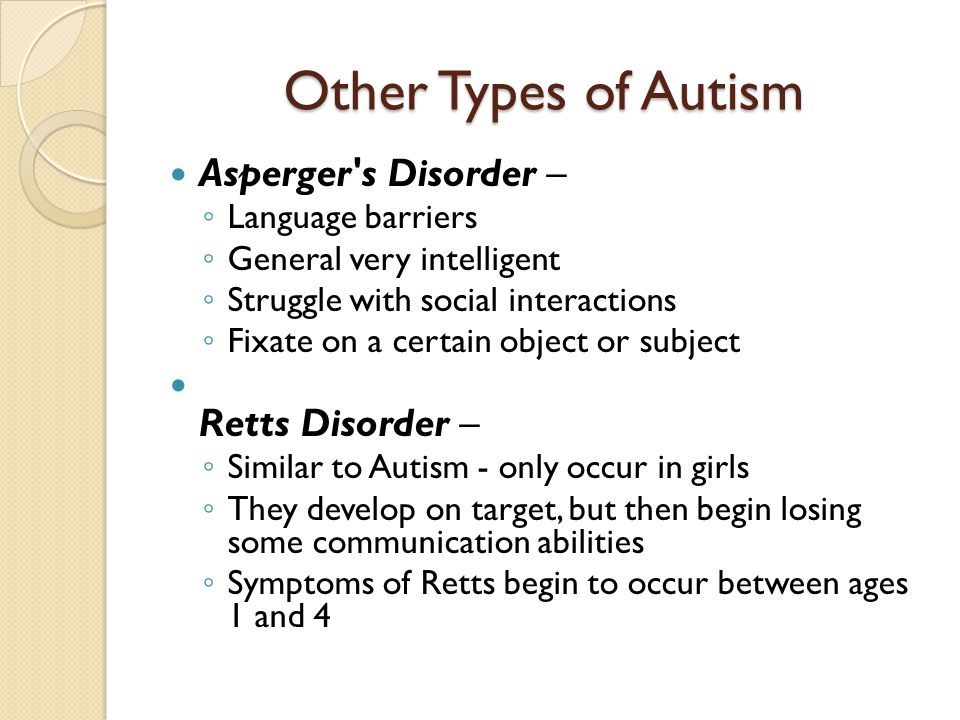 In addition, many people with autism have difficulty controlling anxiety once something triggers it.
In addition, many people with autism have difficulty controlling anxiety once something triggers it.
Anxiety can be triggered at different points in time and by different activities – including some that were previously enjoyable.
Anxiety can be diagnosed by a medical professional.
Treatments include behavioral interventions including cognitive behavioral therapy programs adapted for people with autism. In some cases anti-anxiety medication may also be helpful.
Also see:
- Managing anxiety in children with autism
- Easing anxiety in children with autism and limited verbal skills
Autism and depression
Depression affects an estimated 7 percent of children and 26 percent of adults with autism. By contrast, it affects around 2 percent of children and 7 percent of adults in the general population.
Depression rates for people with autism rise with age and intellectual ability. Autism-related communication challenges can mask depression.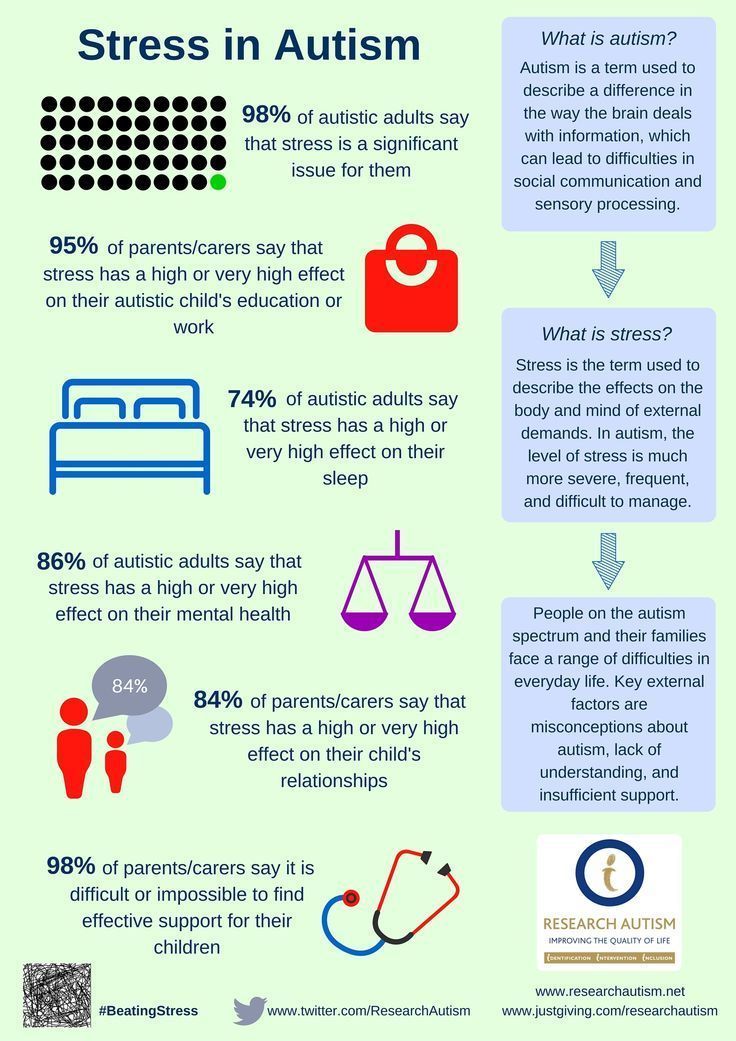 Telltale signs can include loss of interest in once-favorite activities, a noticeable worsening in hygiene, chronic feelings of sadness, hopelessness, worthlessness and irritability. At its most serious, depression can include frequent thoughts about death and/or suicide.
Telltale signs can include loss of interest in once-favorite activities, a noticeable worsening in hygiene, chronic feelings of sadness, hopelessness, worthlessness and irritability. At its most serious, depression can include frequent thoughts about death and/or suicide.
If you suspect that you or your child with autism is depressed, we urge you to seek evaluation and treatment.
Treatments may include cognitive behavioral therapy and in some cases antidepressant medications.
Also see: What's the connection between autism and depression?
Obsessive Compulsive Disorder (OCD)
Research suggests that OCD is more common among teens and adults with autism than it is in the general population.
However, it can be difficult to distinguish OCD symptoms from the repetitive behaviors and restricted interests that are a hallmark of autism.
If you suspect that you or your child has developed OCD in addition to autism, we encourage you to seek evaluation by a mental health provider who has experience with both conditions.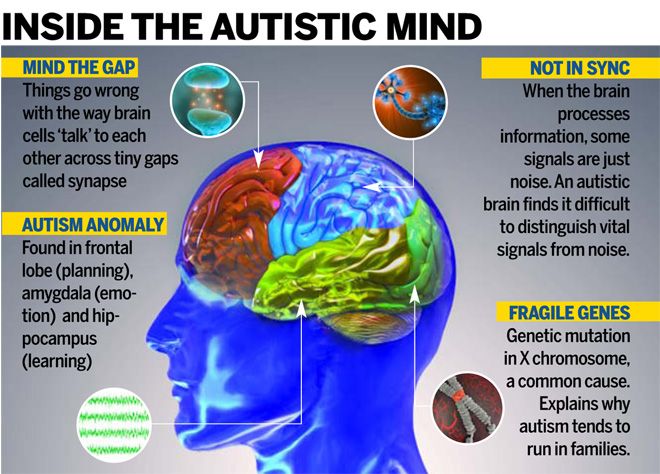
Also see: A parent wonders: Are new repetitive behaviors OCD or ‘just autism’
Autism and Schizophrenia
Autism and schizophrenia both involve challenges with processing language and understanding other people’s thoughts and feelings. Clear differences include schizophrenia’s psychosis which often involves hallucinations. In addition, autism’s core symptoms typically emerge between ages 1 -3 years; schizophrenia emerges in early adulthood.
Treatments: Anti-psychotic medications
Autism and Bipolar Disorder
People with bipolar disorder tend to alternate between a frenzied state known as mania and episodes of depression.
It is important to understand the symptoms of true bipolar disorder from those of autism by looking at when the symptoms appeared and how long they lasted. For example, a child with autism may be consistently high-energy and socially intrusive through childhood.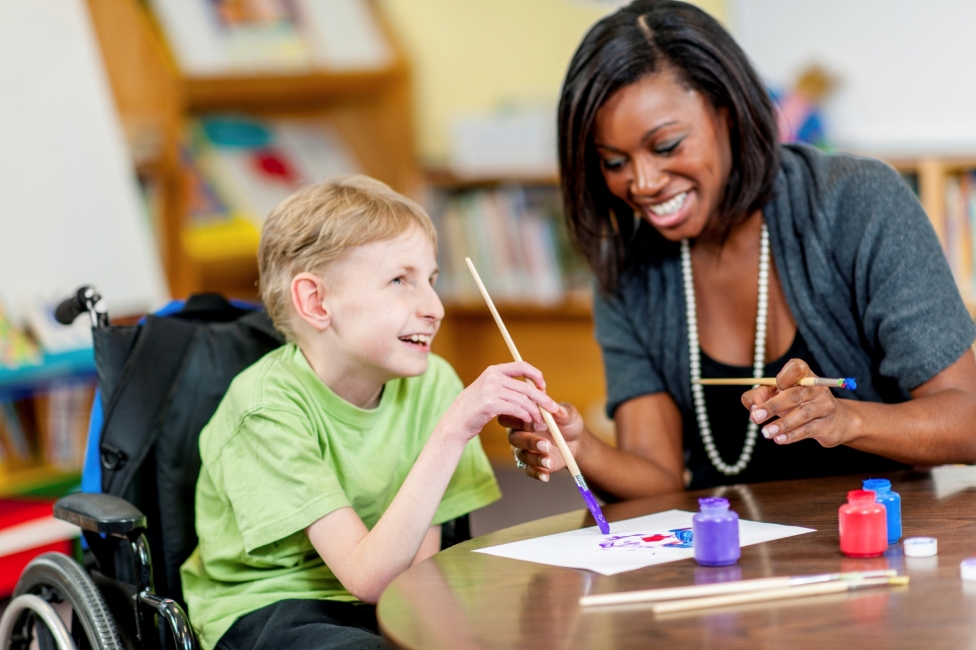 As such, her tendency to talk to strangers and make inappropriate comments are likely part of her autism, and not a symptom of a manic mood swing.
As such, her tendency to talk to strangers and make inappropriate comments are likely part of her autism, and not a symptom of a manic mood swing.
Treatments: Some of the medications used to treat bipolar disorder can be problematic for some with autism who has difficulty recognizing and expressing feelings. A psychiatrist can provide additional medications that may be safer.
Some of these conditions are described more extensively in Autism and Health: A special report by Autism Speaks.
Down syndrome and autism (DS-ASD)
Research shows that about 16-18 percent of people with Down syndrome also have autism spectrum disorder (Richards et al., 2015).
When autism occurs in someone with Down syndrome, the characteristics of autism (social and behavioral challenges, communication difficulties and restricted interests) may be observed in addition to the symptoms of Down syndrome (intellectual disability, speech and language delays).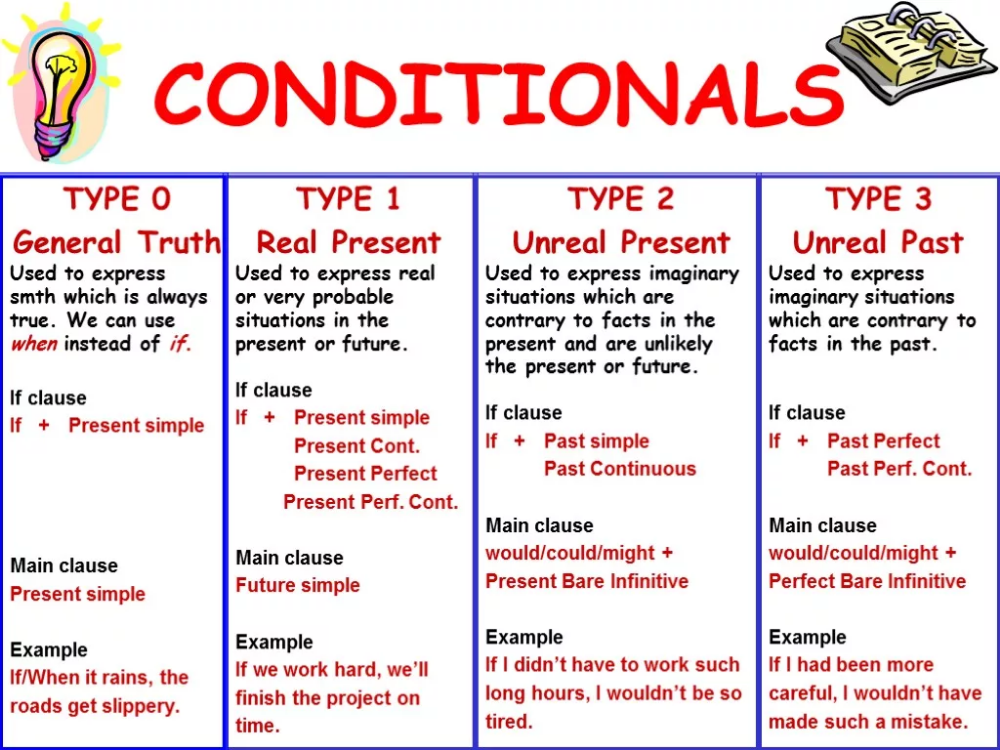
Click here to learn more about the DS-ASD diagnosis.
Autism
Autism- Healthcare issues »
- A
- B
- B
- G
- D
- E
- and
- 9000 About
- P
- P
- With
- T
- in
- F
- x
- hours
- K 9 9000
- S
- B
- E
- S
- I
- Popular Topics
- Air pollution
- Coronavirus disease (COVID-19)
- Hepatitis
- Data and statistics »
- Newsletter
- The facts are clear
- Publications
- Find Country »
- A
- B
- C
- D
- D
- E
- С
- and
- th
- K
- L
- About
- P 9000 In
- Ф
- x
- hours
- Sh
- Sh
- K.
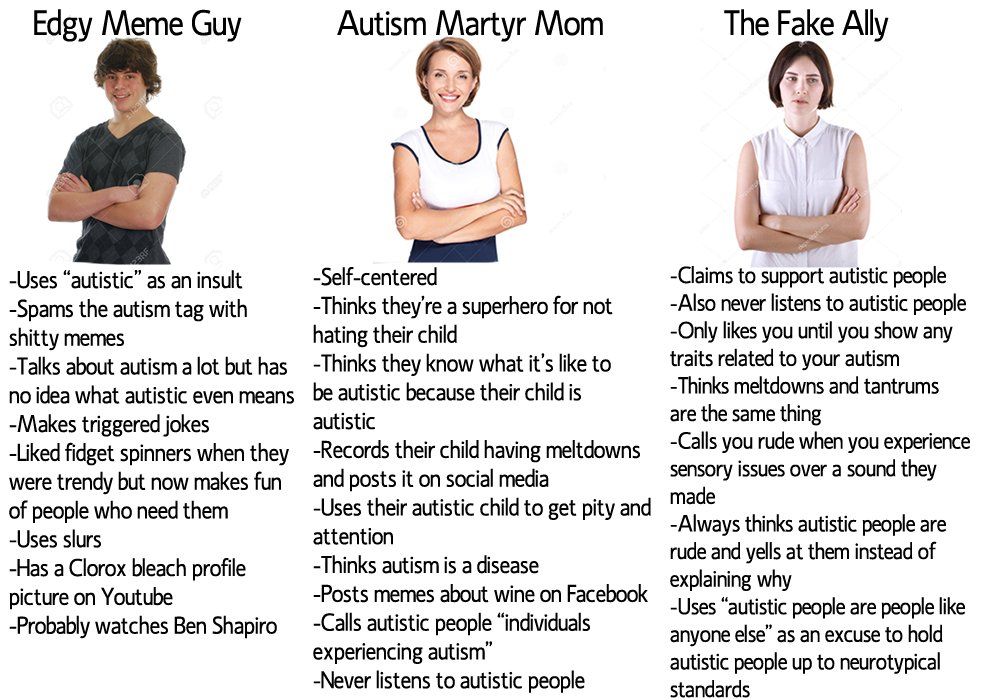
- U
- WHO in countries »
- Reporting nine0005
- Regions »
- Africa
- America
- Southeast Asia
- Europe
- Eastern Mediterranean
- Western Pacific
- Media Center
- Press releases
- Statements
- Media messages
- Comments
- Reporting
- Online Q&A
- Developments nine0005
- Photo reports
- Questions and answers
- Update
- Emergencies "
- News "
- Disease Outbreak News
- WHO Data »
- Dashboards »
- COVID-19 Monitoring Dashboard
- Highlights "
- General director
- About WHO
- WHO activities
- Where does WHO work?
- Governing Bodies »
- World Health Assembly
- Executive committee
- Main page/
- Media Center /
- Newsletters/
- Read more/
- Autism
Key Facts
- Autism, also called autism spectrum disorder, is a diverse group of pathological conditions caused by the development of the brain.
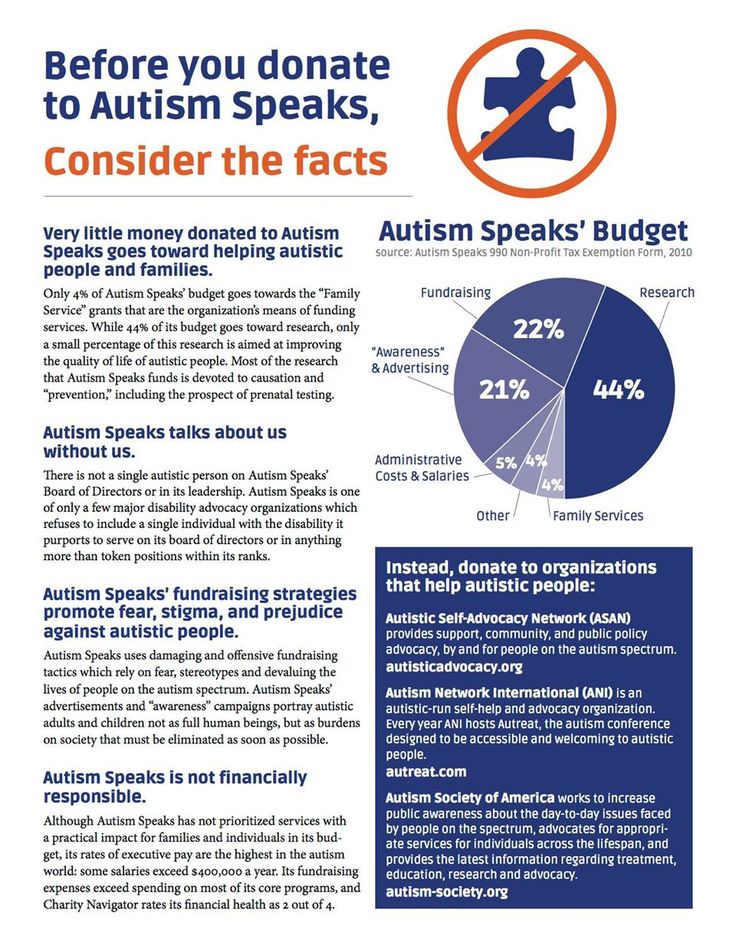
- Signs of autism can be detected in early childhood, but it is often not diagnosed until later in life.
- Approximately 1 in 100 children have autism.
- The abilities and needs of people with autism can vary and change over time. Some people with autism are able to lead independent and productive lives, while others become severely disabled and require lifelong care and support.
- Evidence-based psychosocial interventions can improve communication skills and social behavior that positively impact the well-being and quality of life of people with autism and their caregivers. nine0290
- Care for people with autism must be accompanied by local and community action to make physical and social environments and relationships more accessible, inclusive and supportive.
Introduction
Autism Spectrum Disorders (ASD) are a group of different conditions.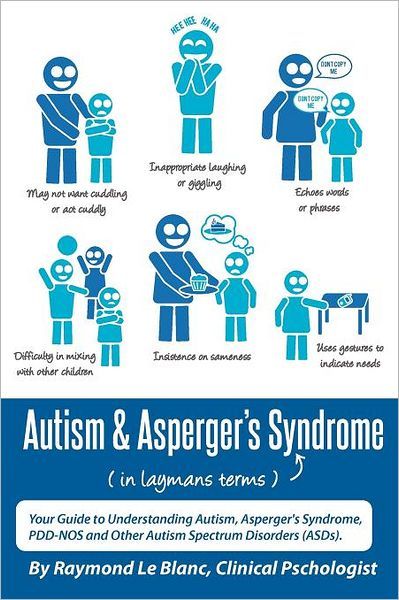 All of them are characterized by certain difficulties with social interaction and communication. Other features include atypical patterns of action and behaviors, such as difficulty moving from one activity to another, focus on details, and unusual responses to external stimuli. nine0324
All of them are characterized by certain difficulties with social interaction and communication. Other features include atypical patterns of action and behaviors, such as difficulty moving from one activity to another, focus on details, and unusual responses to external stimuli. nine0324
The abilities and needs of people with autism can vary and change over time. Some people with autism are able to live independent and productive lives, while others become severely disabled and require lifelong care and support. Autism often negatively affects educational or employment opportunities. In addition, for family members of people with autism, care and support responsibilities can often be a source of significant stress. Community attitudes and the level of support from local and national governments are important determinants of the quality of life of people with autism. nine0324
Signs of autism can be identified in early childhood, but the condition is often diagnosed at much later stages.
People with autism often have comorbid conditions and illnesses, including epilepsy, depression, anxiety, and attention deficit hyperactivity disorder, as well as behavioral problems such as sleep disturbances or self-harm. The level of intellectual abilities of people with autism varies in a wide range from severe cognitive impairment to a high level of intelligence. nine0324
Epidemiology
It is estimated that autism affects about 1 in 100 children worldwide (1). At the same time, we are talking about an average indicator, and the prevalence rates of autism recorded according to different studies vary widely. Nevertheless, according to some reputable controlled studies, the real numbers are much higher. The prevalence of autism in many low- and middle-income countries is unknown.
Causes
Available scientific evidence indicates many factors that may increase the likelihood of children developing autism, including environmental and genetic factors.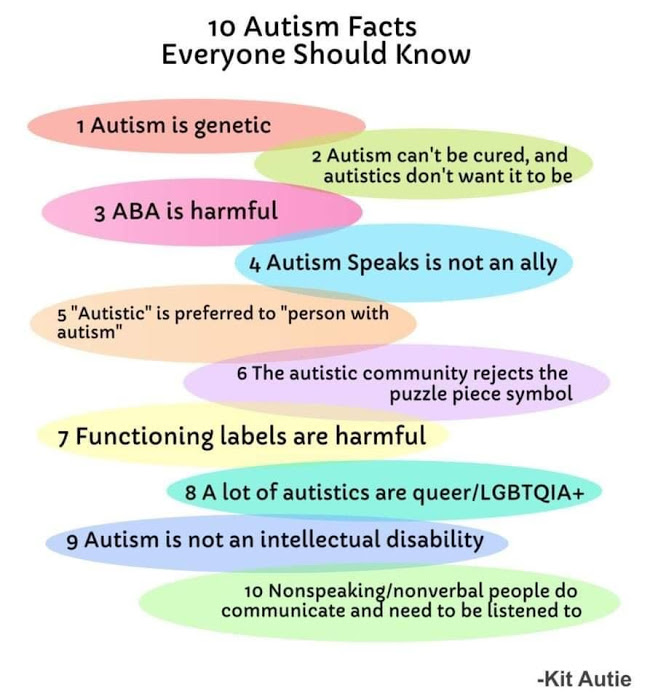
Available epidemiological data do not support a causal relationship between autism and measles, mumps and rubella vaccination. Past studies suggesting such a causal relationship have been many methodological problems were found (2), (3). nine0324
Similarly, there is no evidence that any childhood vaccine can increase the risk of developing autism. Evidence reviews on a potential association between the preservative thiomersal and aluminum adjuvants contained in inactivated vaccines and the risk of developing autism strongly suggest that vaccines do not lead to an increase in this risk.
Needs assessment and care management
A range of interventions, from early childhood and throughout life, can contribute to the optimal development, well-being and quality of life of people with autism. Timely evidence-based psychosocial interventions at an early age can improve the ability of children with autism to communicate and interact effectively with others.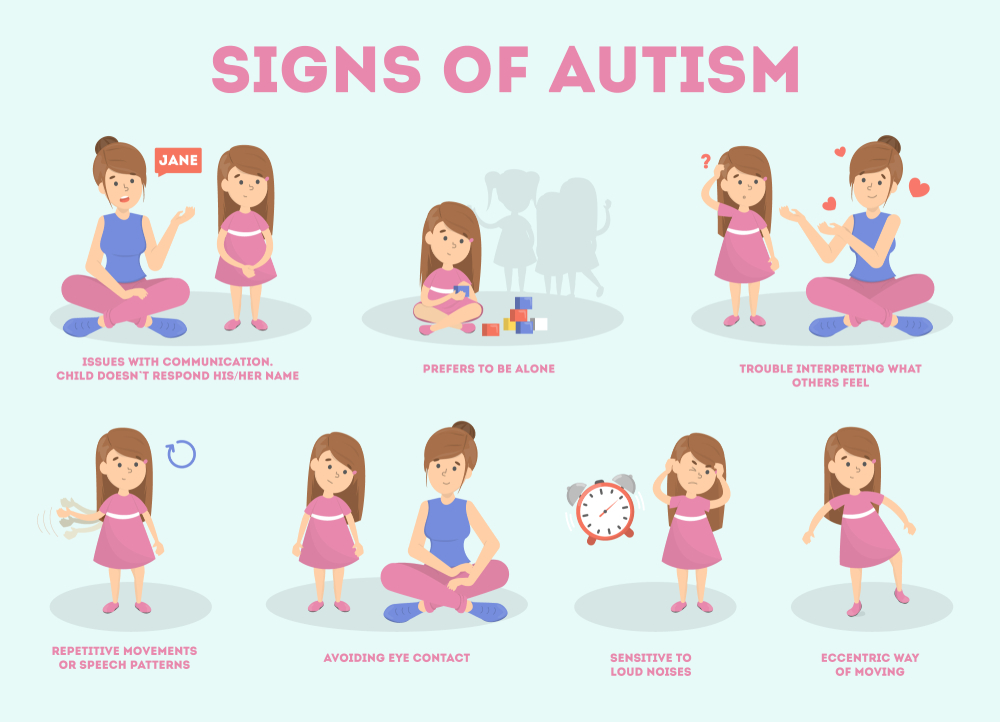 It is recommended to monitor the development of children as part of the planned provision of medical care to mothers and children. nine0324
It is recommended to monitor the development of children as part of the planned provision of medical care to mothers and children. nine0324
It is important that immediately after diagnosis, children, adolescents and adults diagnosed with autism and their caregivers have access to relevant information, referrals and practical support tailored to their individual needs. constantly changing needs and preferences.
The health care needs of people with autism are complex, requiring them to provide comprehensive services, including health promotion, care and rehabilitation services. Therefore, it is important to ensure cooperation with other sectors, in particular with the education system, employment and the social sector. nine0324
Interventions to help people with autism and other developmental disabilities should be planned and implemented with the participation of people with these conditions themselves. Caring for people with autism should be accompanied by local action.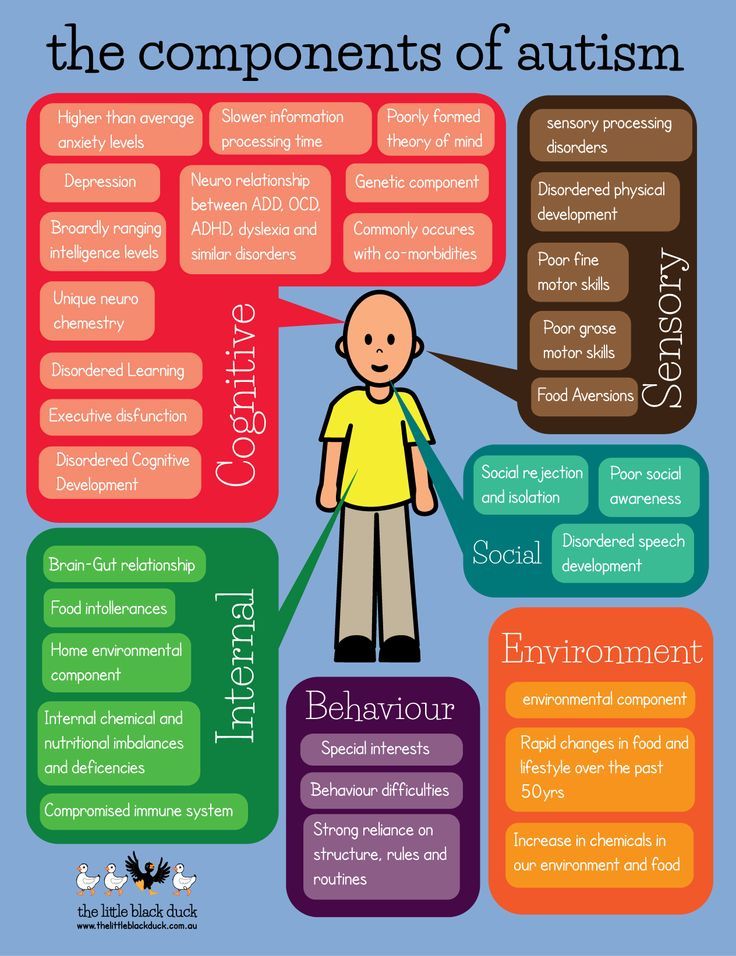 and at the level of society as a whole, in order to make the physical and social environment and relationships more accessible, inclusive and supportive.
and at the level of society as a whole, in order to make the physical and social environment and relationships more accessible, inclusive and supportive.
Human rights
All people, including those with autism, have the right to the highest attainable standard of physical and mental health. nine0324
Yet people with autism often face stigma and discrimination: their health care and education rights are unfairly denied, and their opportunities to participate in society are limited.
People with autism may experience the same health problems as the rest of the population. In addition, they may have special health care needs related to autism and other related conditions. They can be are more vulnerable to chronic noncommunicable diseases associated with behavioral risk factors such as physical inactivity and poor diet, and are at greater risk of violence, injury and abuse. nine0324
People with autism, like the rest of the population, need affordable health services to meet their general health needs, including health promotion and prevention services, as well as acute and chronic disease management.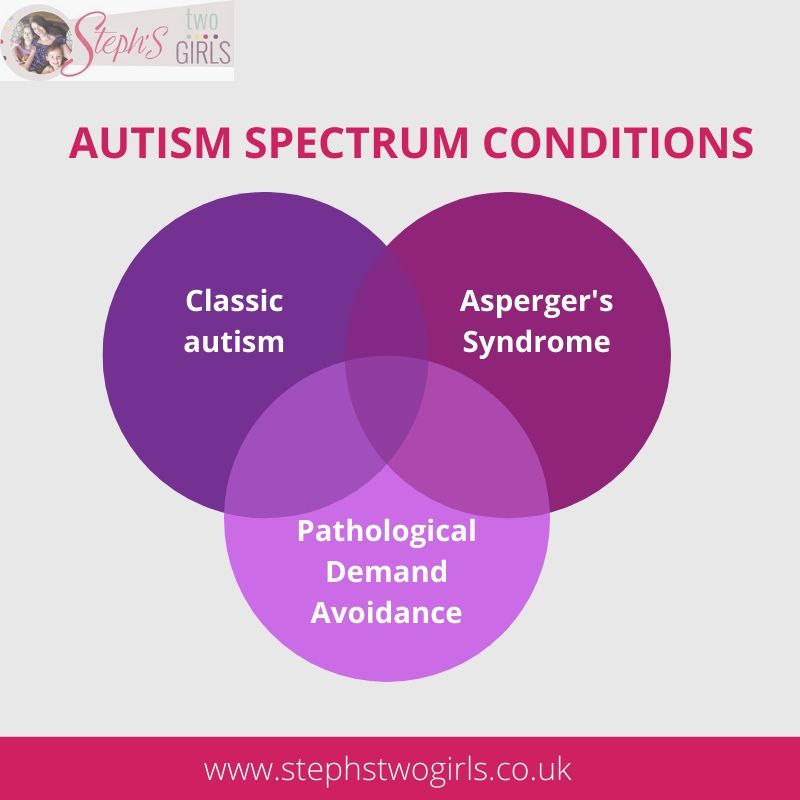 However less than in the general population, the level of satisfaction of the medical needs of people with autism is at a lower level. These people are also more vulnerable in humanitarian emergencies. One of the common barriers is the insufficient level of knowledge and understanding of the specifics of autism by medical professionals. nine0324
However less than in the general population, the level of satisfaction of the medical needs of people with autism is at a lower level. These people are also more vulnerable in humanitarian emergencies. One of the common barriers is the insufficient level of knowledge and understanding of the specifics of autism by medical professionals. nine0324
WHO Resolution on Autism Spectrum Disorders
In May 2014, the Sixty-seventh World Health Assembly adopted a resolution on "Comprehensive and concerted efforts for the management of autism spectrum disorders", supported by over 60 countries.
The resolution calls on WHO to work with Member States and partner agencies to strengthen national capacity to address ASD and other developmental disabilities. nine0324
WHO activities
WHO and partners recognize the need to strengthen the capacity of countries to promote the optimal health and well-being of all people with autism.
The main activities of WHO in this regard are:
- promoting the adoption of targeted measures by national governments to improve the quality of life of people with autism;
- develop recommendations for policies and action plans to address autism in the broader context of physical, mental, brain health and care for people with disabilities; nine0005
- help to empower healthcare professionals to provide appropriate and effective care for people with autism and achieve optimal health and well-being; and
- promote and support an inclusive and supportive environment for people with autism and other developmental disabilities.

WHO comprehensive mental health action plan 2013–2030 and World Health Assembly Resolution WHA73.10 "Global action against epilepsy and other neurological disorders" contain calling on countries to address significant gaps in the early detection, care, treatment and rehabilitation of people with mental and neurodevelopmental disorders, including and autism. The resolution also calls on countries to take action to meet the social, economic, educational and other needs of people living with mental and neurological disorders and their families, and to develop surveillance and related research activities. nine0324
References
(1) Global prevalence of autism: A systematic review update. Zeidan J et al. Autism Research 2022 March.
(2) Wakefield's affair: 12 years of uncertainty whereas no link between autism and MMR vaccine has been proven. Maisonneuve H, Floret D. Presse Med. 2012 Sep; French https://pubmed.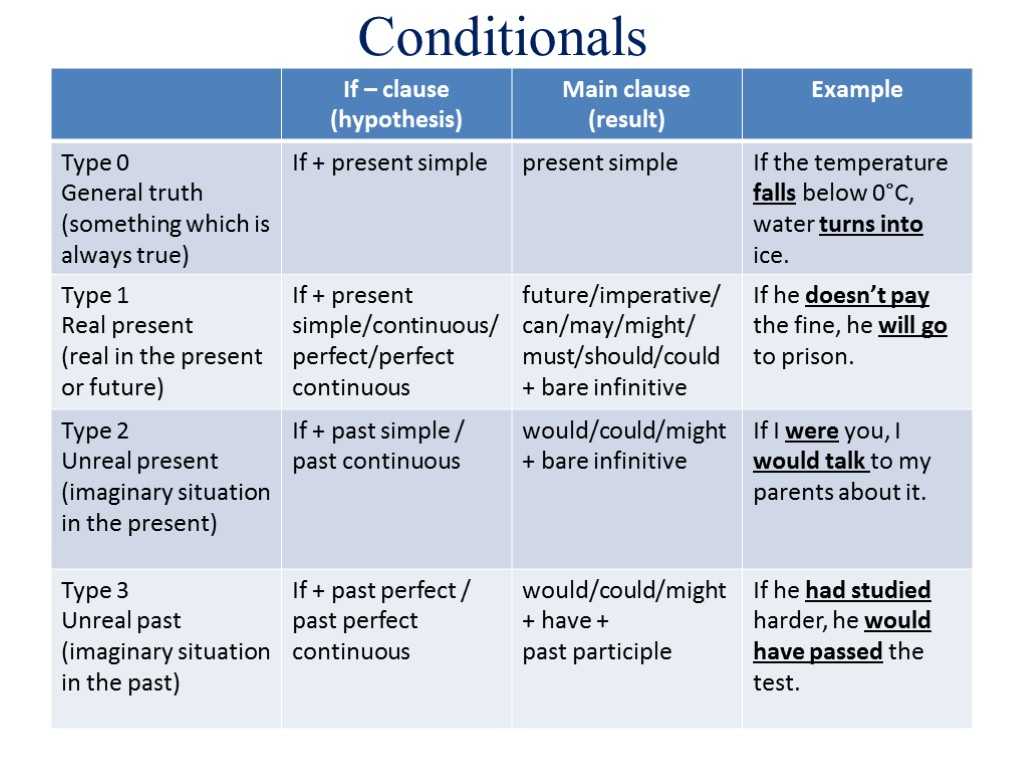 ncbi.nlm.nih.gov/22748860/
ncbi.nlm.nih.gov/22748860/
(3) Lancet retracts Wakefield's MMR paper. Dyer C. BMJ 2010;340:c696. 2 February 2010 https://pubmed.ncbi.nlm.nih.gov/20124366/
"Children of the rain". What you need to know about autism
11 April 2019 12:01
Behind the poetic expression "children of the rain" lies the daily feat of people who are faced with a diagnosis of autism. Children who will never be able to perceive themselves as part of the world around them, and parents for whom every day is a series of battles and victories. First, fighting with yourself, accepting and realizing that their child will never be cured, and then fighting the disease for every gesture, every smile, every look and word of the child - small, but such important victories. nine0324
Scientists have not been able to reliably establish the causes of the disease. It is known about the genetic predisposition: signs of autism are more often manifested in people whose family already has an autistic person.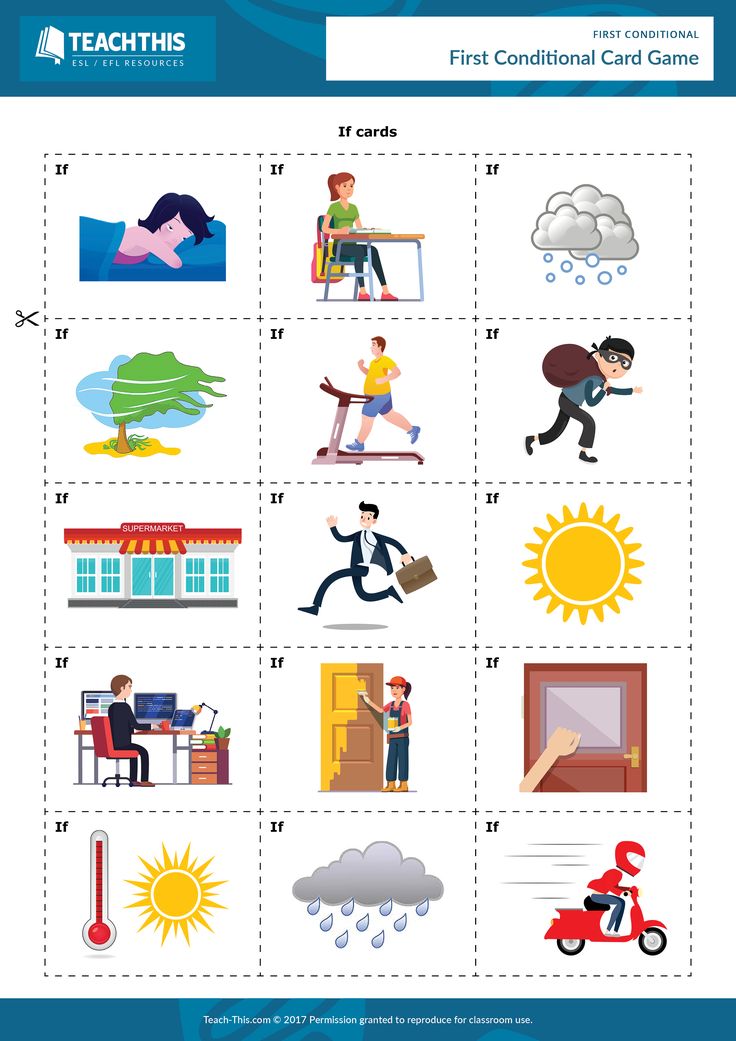 Pregnancy in mothers of such children proceeds normally, and the children themselves are often very attractive in appearance - autism, as a rule, does not affect the physical development of the child. However, the development of autism is still in some cases associated with the manifestation of other diseases:
Pregnancy in mothers of such children proceeds normally, and the children themselves are often very attractive in appearance - autism, as a rule, does not affect the physical development of the child. However, the development of autism is still in some cases associated with the manifestation of other diseases:
- cerebral palsy; nine0004 maternal rubella infection during pregnancy;
- tuberous sclerosis;
- impaired fat metabolism (the risk of having a baby with autism is greater in obese women).
All of these conditions can have a bad effect on the brain and, as a result, provoke symptoms of autism. However, what autism is, and what are the causes of its manifestation, is still not completely clear.
Early diagnosis plays an important role in the further development of an autistic child. Autism in children is manifested by certain signs. Early childhood autism is a condition that can manifest itself in children at a very early age - both at 1 year old and at 2 years old.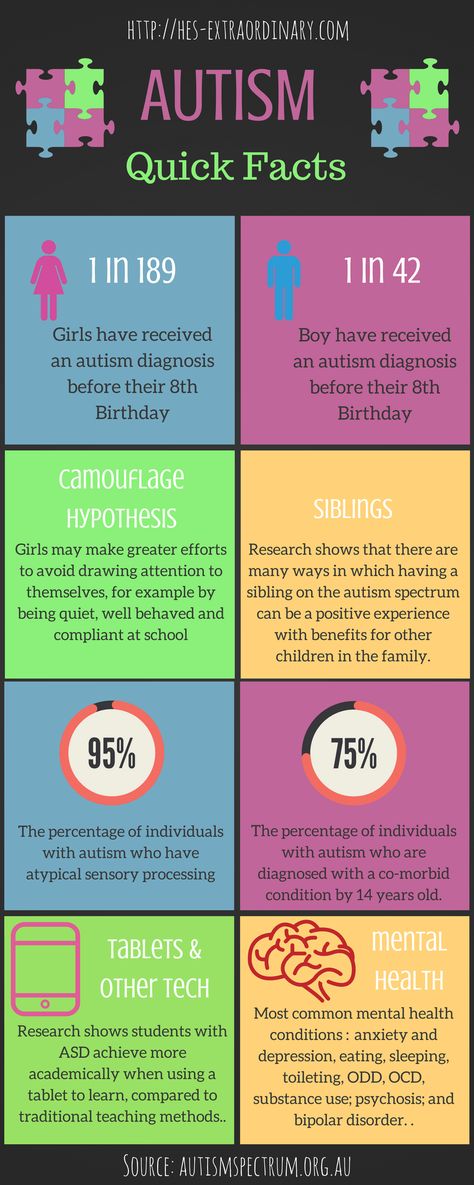 What is autism in a child, and whether this disease occurs, is determined by a specialist. But you can independently figure out what kind of illness a child has and suspect him, based on information about the signs of such a condition. nine0324
What is autism in a child, and whether this disease occurs, is determined by a specialist. But you can independently figure out what kind of illness a child has and suspect him, based on information about the signs of such a condition. nine0324
Early signs of autism in a child
This syndrome is characterized by 4 main signs. In children with this disease, they can be determined to varying degrees.
Signs of autism in children are as follows:
- impaired social interaction;
- broken communication;
- stereotyped behaviour;
- early symptoms of childhood autism in children under 3 years of age.
The first signs of autistic children can be expressed as early as the age of 2 years. Symptoms may be mild when eye-to-eye contact is impaired, or more severe when it is completely absent. As a rule, autism manifests itself very early - even before the age of 1, parents can recognize it. In the first months, such children are less mobile, react inadequately to stimuli from the outside, they have poor facial expressions. nine0324
nine0324
The child cannot perceive a holistic image of a person who is trying to communicate with him. Even in the photo and video, you can recognize that such a baby's facial expressions do not correspond to the current situation. He does not smile when someone tries to amuse him, but he can laugh when the reason for this is not clear to anyone close to him. The face of such a baby is mask-like, grimaces periodically appear on it.
Baby uses gestures only to indicate needs. As a rule, even in children under one year old, interest is sharply shown if they see an interesting object - the baby laughs, points with a finger, and demonstrates joyful behavior. The first signs in children under 1 year old can be suspected if the child does not behave like this. Symptoms of autism in children under one year old are manifested by the fact that they use a certain gesture, wanting to get something, but do not seek to capture the attention of their parents by including them in their game.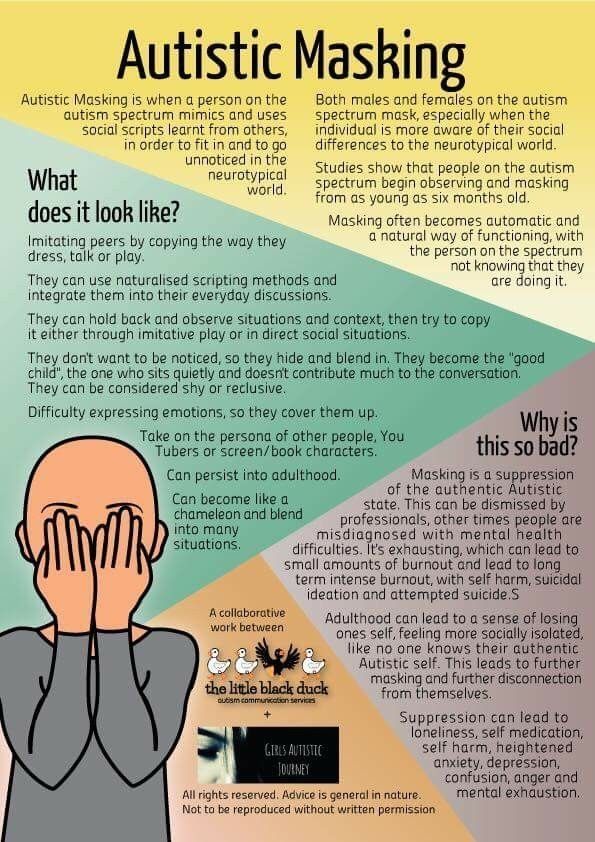 nine0324
nine0324
An autistic person cannot understand other people's emotions. How this symptom manifests itself in a child can be traced already at an early age. If ordinary children have a brain designed in such a way that they can easily determine when they look at other people, they are upset, cheerful or scared, then an autistic person is not capable of this.
The child is not interested in peers. Already at the age of 2, ordinary children strive for company - to play, to get acquainted with their peers. Signs of autism in children of 2 years old are expressed by the fact that such a baby does not participate in games, but plunges into his own world. Those who want to know how to recognize a child 2 years old and older should simply look at the company of children: an autist is always alone and does not pay attention to others or perceives them as inanimate objects. nine0324
It is difficult for a child to play using imagination and social roles. Children 3 years old and even younger play, fantasizing and inventing role-playing games.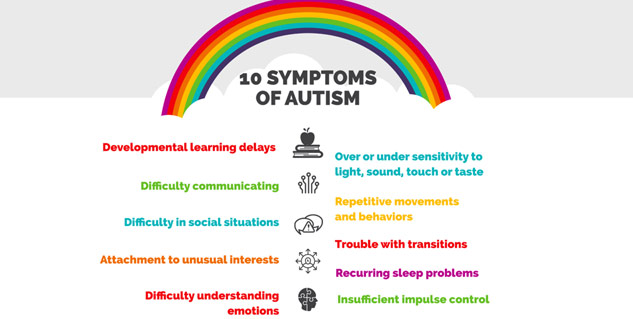 In autistics, symptoms at 3 years old may be expressed by the fact that they do not understand what a social role in the game is, and do not perceive toys as integral objects. For example, signs of autism in a child of 3 years old can be expressed by the fact that the baby spins the wheel of a car for hours or repeats other actions.
In autistics, symptoms at 3 years old may be expressed by the fact that they do not understand what a social role in the game is, and do not perceive toys as integral objects. For example, signs of autism in a child of 3 years old can be expressed by the fact that the baby spins the wheel of a car for hours or repeats other actions.
The child does not respond to emotions and communication from the parents. Previously, it was believed that such children are not emotionally attached to their parents at all. But now scientists have proven that when a mother leaves, such a child at 4 years old and even earlier shows anxiety. If family members are around, he looks less obsessed. However, in autism, signs in children of 4 years old are expressed by a lack of reaction to the fact that parents are absent. The autist shows anxiety, but he does not try to return his parents. nine0324
In children under 5 years of age and later, there is a delay in speech or its complete absence (mutism). The speech is incoherent, the child repeats the same phrases, devoid of meaning, speaks of himself in the third person. He does not respond to other people's speech either. When the “age of questions” comes, parents will not hear them from the baby, and if they do, then these questions will be monotonous and without practical significance.
The speech is incoherent, the child repeats the same phrases, devoid of meaning, speaks of himself in the third person. He does not respond to other people's speech either. When the “age of questions” comes, parents will not hear them from the baby, and if they do, then these questions will be monotonous and without practical significance.
Stereotypical behavior includes obsession with one activity, repetition of daily rituals, development of fears and obsessions. At the same time, if the sequence of the ritual is violated, the child becomes hysterical or may show aggression or self-aggression. nine0324
Can autism be cured and is it curable at all? Unfortunately, there is no cure. How you can help your child depends on each individual case. Drug treatment is prescribed only in case of destructive behavior of a small patient. But, despite the fact that the disease is not curable, it is possible to correct the situation. The best "treatment" in this case is regular practice every day and the creation of the most favorable environment for the autistic.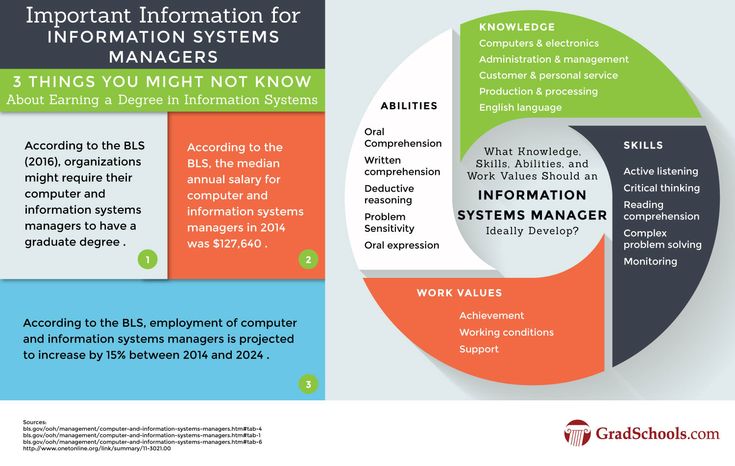 Classes are held in stages:
Classes are held in stages:
- To form the skills that are needed for training. If the child does not make contact, gradually establish it, not forgetting who it is - autistics. Gradually it is necessary to develop at least the rudiments of speech. nine0005
- Eliminate forms of behavior that are non-constructive: aggression, self-aggression, fears, withdrawing into oneself, etc.
- Learn to observe, imitate.
- Teaching social games and roles.
- Learn to make emotional contact.
The most common treatment for autism is practiced according to the principles of behaviorism (behavioral psychology). One of the subtypes of such therapy is ABA therapy. The basis of this treatment is to observe what the reactions and behavior of the baby look like. After all the features are studied, incentives are selected for a particular autist. Speech therapy practice is obligatory: if the kid regularly works with a speech therapist, his intonation and pronunciation are getting better.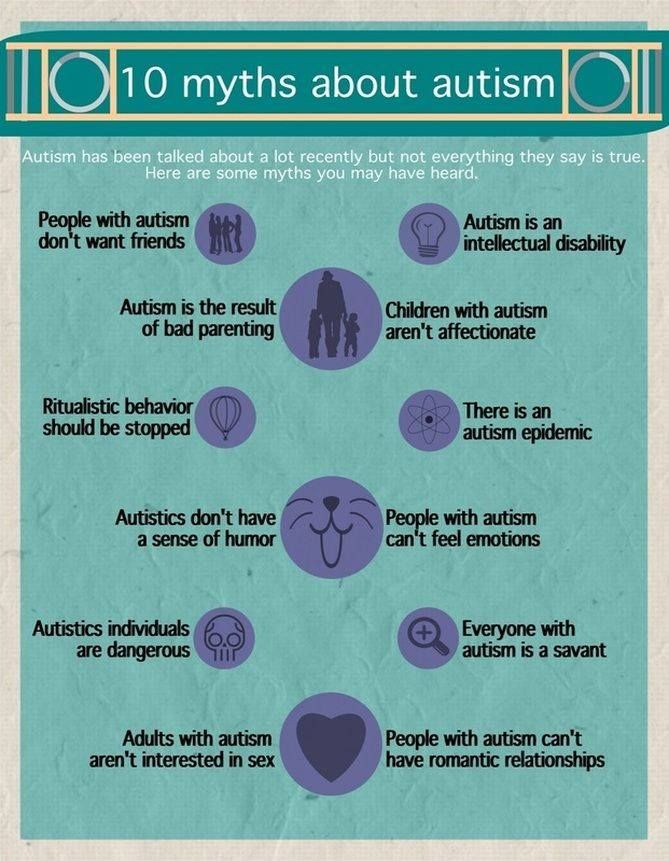 At home, parents help the child develop self-service and socialization skills. Since autists have no motivation to play, they get used to the daily routine, everyday affairs, cards are created where the order of performing this or that action is written or drawn. nine0324
At home, parents help the child develop self-service and socialization skills. Since autists have no motivation to play, they get used to the daily routine, everyday affairs, cards are created where the order of performing this or that action is written or drawn. nine0324
Why is early diagnosis so important? There are conditions that mimic autism that can be confused with its symptoms. But other methods are used to correct them.
ZPRR with autistic features
The symptoms of this disease are associated with a delay in psychoverbal development. They are in many ways similar to the signs of autism. Starting from a very early age, the baby does not develop in terms of speech in the way that existing norms suggest. In the first months of life, he does not babble, then he does not learn to speak simple words. At 2-3 years old, his vocabulary is very poor. Such children are often poorly developed physically, sometimes hyperactive. The final diagnosis is made by the doctor. It is important to visit a psychiatrist, speech therapist with the child. nine0324
It is important to visit a psychiatrist, speech therapist with the child. nine0324
Attention deficit hyperactivity disorder
This condition is also often mistaken for autism. With a lack of attention, children are restless, it is difficult for them to study at school. There are problems with concentration, such children are very mobile. Even in adulthood, echoes of this state remain, because it is difficult for such people to remember information and make decisions. You should try to diagnose this condition as early as possible, practice treatment with psychostimulants and sedative drugs, and visit a psychologist. nine0324
Hearing loss
These are various hearing impairments, both congenital and acquired. Hearing-impaired children also have speech delays. Therefore, such children do not respond well to the name, fulfill requests and may seem naughty. At the same time, parents may suspect autism in children. But a professional psychiatrist will definitely send the baby for an examination of auditory function.